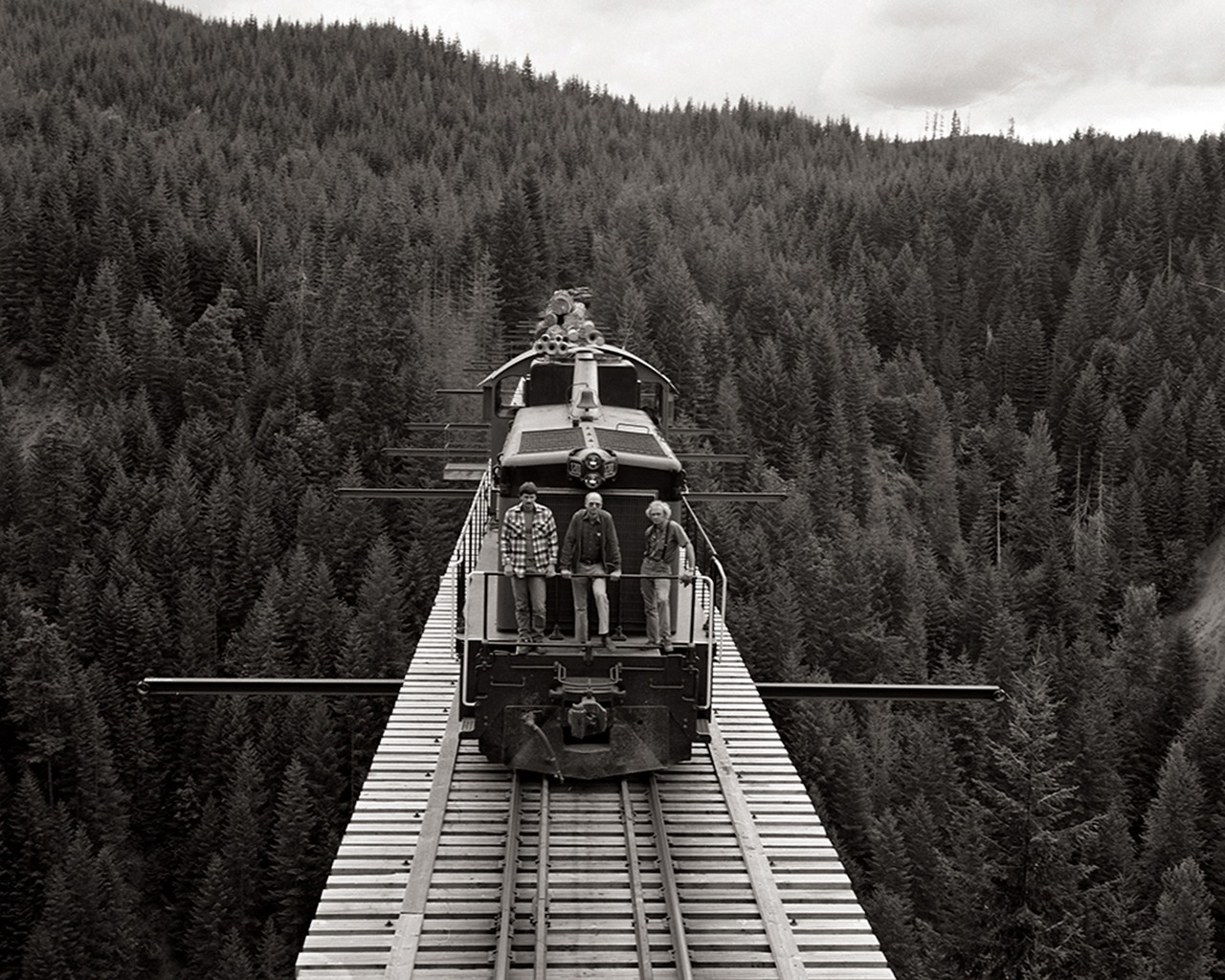‘On the Harbor From Black Friday to Nirvana,” the book published by The Daily World in 2001, features two of the great photos from the glory days of logging on the Olympic Peninsula.
In 1922, the legendary B.B. Jones hiked deep into the woods one spring day to capture two mustachioed young loggers on springboards about a third of a way through a towering old-growth Doug fir. A few weeks later, one was killed by a “widow maker,” a loose limb, often as thick around as a man’s body, falling like a pile driver. It happened all the time.
A year later, the Labor Day photo Jones took for posterity had a happier ending. Twenty members of a Schafer Bros. Logging Co. crew working near Brady posed with a railcar load of logs—one marked “67 LOADS.” That’s how many cars they loaded in one day. The boss had bet them they couldn’t do it.
The new exhibit at the Polson Museum in Hoquiam features the evocative work of a gifted photographer who set out in the 1980s to replicate the classic logging photos taken by the likes of Jones and his more famous contemporary, Darius Kinsey.
John Tylczak’s “Views from the Northwoods” opens at the Polson this Saturday and will run through the end of the year. Tylczak’s work is one of our state’s historically significant and artistically impressive modern hidden treasures. Like Kinsey and Jones, the Tacoma-based photographer is a master of the large-format view camera capable of producing images of almost three-dimension clarity and gradation.
Tylczak says his mission “came into sharper focus one day while waiting in my Volkswagen bug for a Simpson Timber Company locomotive with its long line of freshly cut logs to clear an intersection in downtown Shelton. That was in 1983. I suspect, however, that the idea actually started percolating much earlier. It might have been the rainy autumn day I wandered into a small Connecticut bookstore and spent more than an hour leafing through Dave Bohn’s newly published volume of Darius Kinsey images. … Between 1890 and 1940, Kinsey made thousands of exquisite 11-by-14 inch images. When I discovered the book, I was in graduate school. That was 1978. But it might be possible that the project subconsciously began percolating even earlier to a time in my early childhood — from those special times, hand-in-hand with my grandfather, A.E. Hillier, who had directed the Phoenix Logging Co. at Potlatch on Hood Canal in the 1920s for more than a dozen years.”
It’s altogether fitting — and a tinge ironic — that “Northwoods” should be spotlighted by the Polson Museum, the former home of a scion to the Polson Logging Co. empire. That splendid house was the fruit of the labors of countless loggers, saw filers and boom men.
Like me, John Larson, the museum’s director, is steeped in the lore of the industry. Unlike me, he is marvelously mechanical. At parades, he loves to tool around in one of those old lumber carriers that look like tractors on stilts. Larson and a corps of volunteers are resuscitating an historic logging locomotive. The Polson is a collective labor of love.
In photography, timing is everything. Tylczak captured the images for “Northwoods” during the 1980s, traveling around the Northwest to logging shows and sawmills just before the dramatic timber harvest reductions to protect the Northern spotted owl changed everything. This exhibit focuses on scenes from Grays Harbor and Mason counties.
One photo in particular makes me smile — and sad. It shows my friend, the late Werner Mayr, who started logging during the Depression with his brother and a pair of mules. Wearing a cruiser jacket over his plaid shirt, his jeans hiked up by suspenders, Werner is surveying a Mayr Brothers Logging Co. operation on Cougar Mountain in the spring of 1987.
Less than two years later, the Forest Service dealt the resilient old logger a bitter pill. The Mayrs’ mill depended almost entirely on hemlock logs from the Olympic National Forest. Now it was survival of the fittest. And in the end, even most of the fittest went back to the sky.
Chances are you’ll see familiar faces in this exhibit: the crew at the Aloha Shake Mill on March 10, 1987; Don Anderson, a saw filer at Simpson’s Camp Grisdale — the last of the Mohicans — on June 21, 1985; Danny DePriest, a log truck driver, with his cutie-pie young daughter, Emma, at Weyerhaeuser’s Aberdeen Log Yard on an April day in 1987.
The main exhibit room at the museum features Tylczak’s beautiful black-and-white prints. An additional 180 photos will be digitally projected in a looping slide show. On Saturday, from 1 to 4 p.m., you can meet Tylczak at an artist’s reception and grand opening of the exhibit.
John C. Hughes, former editor and publisher of The Daily World, is chief historian for the Secretary of State’s oral history program, Legacy Washington.


